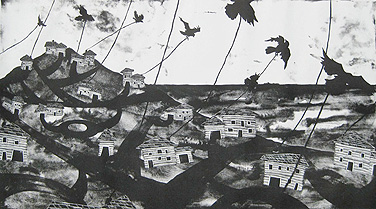News
Exhibition celebrates work of recent grads

Amanda Maciuba, “Attachment,” 2009.
-
 Print
Print -
 Comments
Comments
-

Rob Rzeznick, Screenshot from “Father Richard-—Episode II,” 2009. Flash Animation.

Andrew Vaga, “Rorschach and The Tortoise,” 2009. Interactive Video.
The work of three exceptional artists, recent graduates of UB’s Department of Visual Studies, will be featured in the exhibition titled “Noncommittal: A Prospective Glance 2” on view today through Dec. 12 in the UB Art Gallery in the Center for the Arts, North Campus.
The show will be presented in collaboration with the Department of Visual Studies.
The exhibit, which will take place on the second floor of the gallery, is free and open to the public. A public reception for the artists will be held from 5-7 p.m. Nov. 5.
According to Sandra Q. Firmin, gallery curator, and Millie Chen, associate professor and chair of the Department of Visual Studies, the three artists selected for this exhibition—Amanda Maciuba, BFA print media ’09; Rob Rzeznik, BFA emerging practice, ’09; and Andrew Vaga, BFA communication design, ’09—were chosen for the high quality of their work, depth of vision and how their work addresses the ways technology and architecture influence interpersonal relationships.
“Maciuba, Rzeznik and Vaga draw from the rich scope of present-day contemporary art practice to critique the dissolution of communities due to the establishment of both physical barriers, which isolate people in their homes and apartments, and technological ones, which rely on a model of entertainment based on passive consumption,” says Firmin.
Maciuba’s haunting black-and-white prints illustrate rural communities undergoing a transformation into alienating suburban enclaves. She employs a poetic vocabulary of houses tethered together by ribbons. They, in turn, are ensnarled in trees like Christmas decorations and carried away by ravens.
“Recently, Maciuba expanded her practice to include wall drawings,” says Chen, “and this exhibition will be the first opportunity she has had to create a large-scale installation incorporating sculpture, wall drawing and prints.”
While Maciuba offers an exterior view of cookie-cutter houses vulnerable to unspecified threats, Rzeznick explores potentially combustible scenarios suggested by what we find on television and computer screens.
Now available on YouTube and on his MySpace page, Rzeznick’s darkly humorous animations are mash-ups of a range of television genres—from courtTV and adult cartoons, to Sesame Street and shoot-’em-up videogames. His work is a commentary on a culture inured to mindless TV flipping and Web surfing.
“In the gallery, where their ability to shock is amplified,” Firmin says, “Rzeznick’s videos seem to ask about the consequences of prolonged exposure to violence in the media on our interpersonal relationships and our capacity for empathy.”
Vaga, who also references media in his work, does not take such a nightmarish view.
“Nevertheless,” Firmin says, “he is equally concerned about the fact that communication technologies for multitasking and social networking encourage conversations that occur in tweets and abbreviations.
“In an interactive installation in the show,” she says, “he repurposes a Web cam, which is routinely used to connect people across distances, using it to capture and abstract people’s movements on a bank of computer monitors, allowing them to creatively engage the technology to generate pixilated patterns.”
Chen points out that a seismic shift has occurred recently in art school curricula. “Today, less emphasis is placed on the mastery of a single area of concentration and more on the integration of art practice and history with theory to effectively address prevalent aesthetic and societal concerns,” she says.
Adds Firmin: “This trend is reflected in the UB Art Gallery’s pedagogical mission to present and interpret temporary exhibitions that examine the dynamic between contemporary art, and cultural and socio-political topics.
“Both the UB Art Gallery and Department of Visual Studies are committed to the practice and scholarship surrounding the history, critical study and making of art,” she says. “By fostering the creation and presentation of artwork by students who have shown both a dedicated commitment to their art practice and a critical engagement with the world, the ‘Noncommittal’ series supports the continued professional development of these young artists at a critical juncture in their post-undergraduate careers.”
The ongoing mission of the gallery and the department is to further the scholarship of young art historians and critical theorists. In addition, Allison Bosch and Denise Lang, students in the graduate program in art history, and José Felipe Alvergue, a doctoral candidate in the UB Poetics Program, contributed thoughtful and insightful essays on each of the artists in the exhibition.

Reader Comments